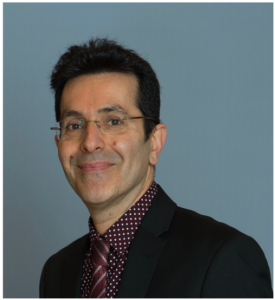
Distinguished Professor Saeid Nahavandi
Title: Emerging haptically-enabled systems for immersive simulation-based training
Bio:
Distinguished Professor Saeid Nahavandi is currently Swinburne University of Technology’s inaugural Associate Deputy Vice-Chancellor Research and Chief of Defence Innovation. He previously served as Pro Vice-Chancellor (Defence Technologies) and Founding Director of the Institute for Intelligent Systems Research and Innovation, Deakin University. Saeid received a Ph.D. from Durham University, UK in 1991. His research interests include autonomous systems, modeling of complex systems, robotics and haptics. Saeid was the recipient of the Clunies Ross Entrepreneur of the Year Award 2022 from the Australian Academy of Technological Sciences & Engineering, Researcher of the Year for Australian Space Awards 2021, Australian Defence Industry Awards – Winner of Innovator of the year, The Essington Lewis Awards, and Australian Engineering Excellence Awards – Professional Engineer of the Year.
Professor Nahavandi holds six patents, two of which have resulted in two very successful start-ups (Universal Motion Simulator Pty Ltd and FLAIM Systems Pty Ltd). Saeid is the Vice President: Human-Machine Systems, IEEE SMCS and Co-EIC: IEEE Systems Journal. Professor Nahavandi is a Fellow of IEEE (FIEEE), Engineers Australia (FIEAust), the Institution of Engineering and Technology (FIET) and the Australian Academy of Technology and Engineering (ATSE).
Abstract:
This talk will explicate the integration of haptic (force feedback) technology into VR/MR systems to increase their fidelity for SBT. Through this innovation, a user is able to “touch-and-feel” virtual and/or remote objects, and perceive their attributes via haptically-enabled VR/MR systems. As such, the user can feel the object properties, such as texture or hardness/softness characteristics, when utilising these haptically-enabled SBT tools in an immersive environment for skill acquisition.
This talk will focus on the design and development of a series of haptically-enabled systems, particularly haptically-enabled motion simulators, firefighting trainers, and tele-healthcare robotic systems, for SBT purposes. Serving as a flight/vehicle simulator, the developed robotic-based platform is integrated with haptically-enabled peripherals, such as haptic chairs and haptic control devices, to offer a high-fidelity training environment. The user can enjoy realistic flying/driving experiences, e.g., air turbulence or rough terrain, during training. On the other hand, the haptically-enabled hot-fire trainers enable the user to experience realistic jet reaction forces from the hose and provides immersive water dispersion and interaction with fire and smoke particles based on accurate physics modelling via the VR/MR-based tools. In addition, a haptically-enabled ultrasound scanning system for tele-healthcare applications will also be exemplified. It allows the user (sonographer) to remotely “touch-and-feel” the anatomical structure of a patient during tele-scanning, allowing accurate diagnosis of patients in tele-health services.
Distinguished professor Sanjay K Madria
Title: MinerFinder: A GAE-LSTM method for predicting spatio-temporal locations of miners in underground mines
Bio:
Dr Sanjay K. Madria is a Curators’ Distinguished Professor in the Department of Computer Science at the Missouri University of Science and Technology (formerly, University of Missouri-Rolla, USA). He has published over 300+ Journal and conference papers in the areas of cybersecurity, mobile and sensor computing, big data, cloud computing, and data analytics. He won five IEEE best papers awards in conferences such as IEEE MDM and IEEE SRDS. He is a co-author of a book (published with his two PhD graduates) on Secure Sensor Cloud published by Morgan and Claypool in 2018. He has supervised 20 PhDs and 34 MS thesis students and currently supervises 10 doctoral candidates. NSF, NIST, ARL, ARO, AFRL, DOE, Boeing, CDC-NIOSH, ORNL, Honeywell, and other major companies have funded his research projects of over $25 million. He has been awarded JSPS (Japanese Society for Promotion of Science) invitational visiting scientist fellowship, and ASEE (American Society of Engineering Education) fellowship. In 2012 and in 2019, he was awarded the NRC Fellowship by National Academies in the United States. He is an ACM Distinguished Scientist and served as an ACM and IEEE Distinguished Speaker. He is a IEEE Senior Member as well as a IEEE Golden Core Awardee.
Abstract:
Recent reports by the Mine Safety and Health Administration suggest that several injuries and fatalities could be attributed to the inability to accurately locate miners in case of disasters. Since underground mines have a complicated geometrical landscape and technological constraints such as no GPS information available, it is difficult to predict the location of a miner and hence may lead to delays and inefficiencies in rescue operations during a disaster. A significant amount of research has been done to capture complex spatio-temporal relationships of movement of the nodes/people/things with time, spatial and temporal features to separately extract these relationships for location prediction. Although Markov Chains (MC) and Recurrent Neural Network (RNN) based methods have been used to predict locations, not all of them specifically mention the spatial locations, their connections and the aggregation techniques which would allow for the actual representations of the trajectory of miners. Addressing these concerns, we developed a first-of-its-kind end-to-end system entitled MinerFinder to predict the future location of the miners by incorporating Long Short-Term Memory (LSTM) for trajectory information with Graph Autoencoder (GAE) for spatial environmental information representing the node connectivity. In addition, our approach will combine the miners’ previous trajectories and daily repetitive patterns enhancing the prediction robustness. We evaluated MinerFinder over synthetic dataset to analyze the structure and location topology of an underground mine compared with foreground locations. Our model outperforms state of the art models and achieves an AP score ranging from (0.62 – 0.68) and Receiver Operating Characteristics (ROC) ranging from (0.63–0.68) with increasing percentage of prominent locations (most visited) to 50%. We have implemented this on a mobile platform using Delay-tolerant Opportunistic Network where predictions are performed in a federated way.


